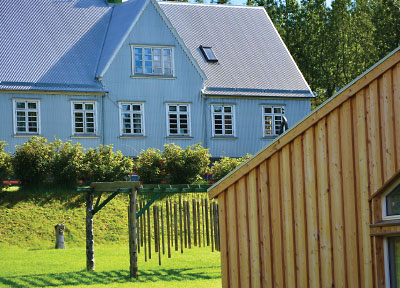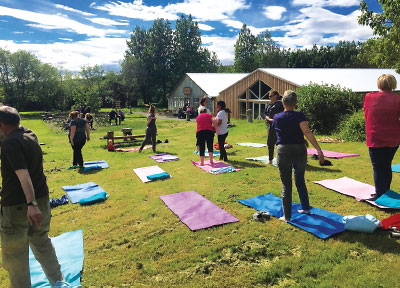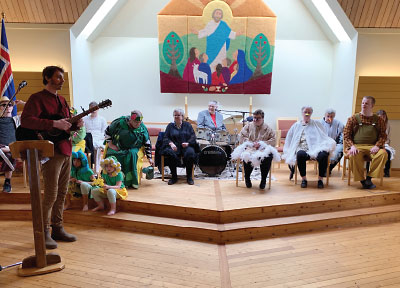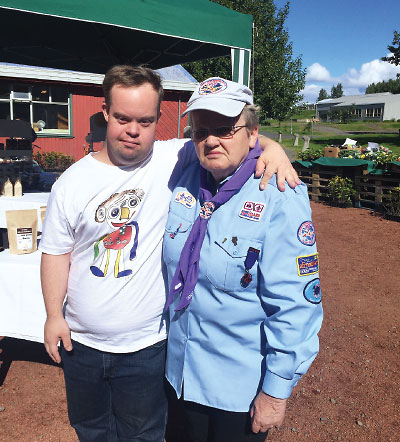Icelandic Community for People With Disabilities Built on Reverse Integration, Sustainability
Abstract
The 90-year-old ecovillage offers support to residents with disabilities while encouraging independence and creative expression.

The Sólheimar Ecovillage in Iceland was founded in 1930 for foster children. Today the village is home to more than 100 people, nearly half of whom have a mental illness or intellectual disability. Guiding principles of the village are that everyone lives and works together and contributes to its being self-sustainable. Above is the village’s first house.
In September, the northern lights unfurled over the skies of Sólheimar Ecovillage in Iceland. It was rather early in the season for the phenomenon, said Hallbjörn Rúnarsson, social educator at Sólheimar, yet for the sustainable community that emphasizes the connection between humans and nature, the northern lights are a fitting addition to the sweeping Icelandic landscape.
The community is known for its artistic and ecological endeavors, but at its heart, Sólheimar is home to more than 100 people, nearly half of whom have a mental illness or intellectual disability. The residents all live and work together, and their ages range from under a year to more than 80. Some have lived in the community their entire lives.
“At the core of everything we’re doing, we’re supporting people so they can live independently,” said Rúnarsson.
Sólheimar is an example of “reverse integration,” meaning the community developed based on the needs of its residents with disabilities, and those without disabilities adapted to their needs. “In my mind, this is simply a community of people,” Rúnarsson said. “It just so happens that there are many people here who need special attendance.”

Residents practice yoga in Sólheimar.
Iceland’s first community for children with disabilities, Sólheimar was founded in 1930 by Sesselja Sigmundsdóttir, who had studied pedagogy, childcare, and the operation of orphanages in Denmark, Switzerland, and Germany. At only 28 years old, she founded the community in southeast Iceland, about 85 kilometers outside Reykjavik. It is situated in a valley fed by hot springs, allowing the community to access its own hot water.
Sigmundsdóttir began the community with five foster children, and over time, children with disabilities arrived in Sólheimar. “In those days, sometimes people just didn’t want their children if they were born with a disability,” Rúnarsson said. “They wanted the system to take care of them.”
Eventually, the government stepped in and told Sigmundsdóttir that she would have to build a separate house for the children with disabilities. She strongly disagreed, Rúnarsson said. She believed that people should be together regardless of whether they have disabilities. “That’s how these strong roots started here,” he said.

The Sólheimar theater group presents its annual production. The theater group will celebrate the community’s 90th anniversary in 2021.
Today the community accepts people of all ages. When individuals apply to live in Sólheimar, the community coordinates with the person’s municipality of residence and evaluates the applicant using the American Association on Intellectual and Development Disabilities’ Supports Intensity Scale (SIS) to determine what level of support he or she needs in such areas as personal, work-related, and social activities. Sólheimar then sets up a service contract with the municipality to provide that individual with the needed services.
For the residents, Sólheimar’s mission is to emphasize the importance of autonomy and personal choice. “The first thing that we ask an applicant is: Is it your will? Do you want to live here or is there someone telling you that you want to live here?” Rúnarsson said. “We always want to be certain that people are making this decision themselves.”
The community’s goal is to build a society in which all people, no matter their disabilities, are welcome while also ensuring that the community is as sustainable as possible. It relies on some external sources, such as government funding for social services, and it exchanges hot water for cold water with a nearby farm. But as much as possible, Sólheimar tries to create a cohesive relationship with the environment, using renewable energy, such as geothermal energy from the hot springs, and feeding its residents with food grown in the organic garden.

Two residents pose for a photo at the community’s organic market.
There are plenty of opportunities for employment in the community, too, including working in forestry, the greenhouse, the post office, the café, and the secondhand market. The community recently started working with a large laboratory company that was throwing away plastic trays used to hold test tubes after one use. The company now pays Sólheimar’s residents to clean the trays and return them for further use. “We are always trying to reach out to other communities to show them how we would like to help them,” Rúnarsson said.
Sólheimar is also well known for its thriving cultural life and encourages residents to express themselves creatively. There are five arts workshops from which they can choose to participate: art, ceramics, weaving, wood working, and candle making. There are also a music workshop and theater group, which presents a play every year on the first day of summer. This year, the residents in the theater group wrote a play about Sigmundsdóttir’s life, adding a touch of fantasy by including classic creatures of Icelandic folklore, such as trolls and elves.
Every summer Sólheimar has an art exhibition during which residents can sell what they have made. The proceeds support the overall community, but residents can keep a portion for themselves.
“I wanted to be here because I think we can make a perfect example of a community in which we can all live together cohesively no matter our abilities,” said Rúnarsson, who also lives in Sólheimar with his family. “That’s what we’re doing with this sustainable piece, as well. This small community can show the rest of the world: This is how it can be.” ■



